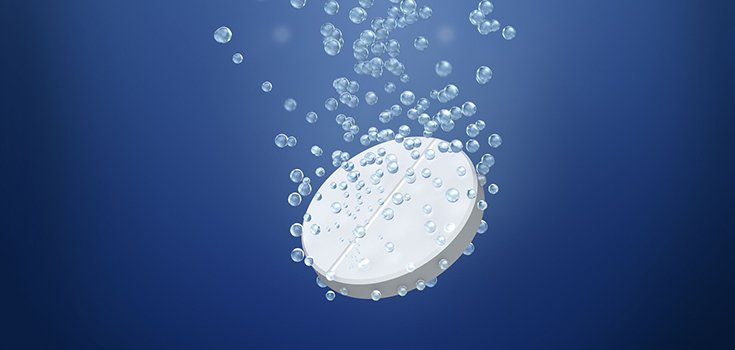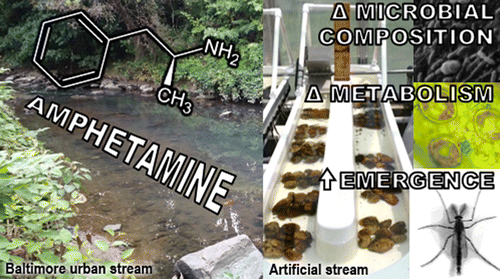How Illegal Drugs and ADHD Medications are Polluting Urban Streams

Both legal and illegal drugs are polluting streams in and around at least 1 major U.S. city, a new study reveals. This includes amphetamines, which are biologically active and highly addictive. [1]
The pollution comes at a high cost, ecologically. Areas in some streams have high enough concentrations of amphetamines to alter the bottom of the aquatic food chain.
Study author Sylvia Lee said:
“Around the world, treated and untreated wastewater entering surface waters contains pharmaceuticals and illicit drugs that originate from human consumption and excretion, manufacturing processes, or improper disposal.
We were interested in revealing how amphetamine exposure influences the small plants and animals that play a large role in regulating the health of streams.”
What are Amphetamines?
Amphetamines are stimulant drugs that are often used prescribed by doctors to treat attention deficit hyperactivity disorder (ADHD) and narcolepsy. Illegal amphetamines include cocaine and crystal meth. [2]
How This Impacts Aquatic Life and Environments
In 2013 and 2014, Lee and her colleagues collected water samples from 6 sites in streams flowing from a city to a rural area and measured the concentrations of both legal and illegal drugs in the water.
The streams originated in Baltimore, Maryland. The stream sites involved the Gwynns Falls watershed, in addition to 2 rural streams from the Oregon Ridge watershed.
The water tested positive for many substances, including amphetamines. Levels of illegal drugs were highest in the streams closest to the city.

Once the team collected their field samples, they conducted an artificial stream experiment to demonstrate how amphetamine affects stream life.
Study co-author Emma Rosi-Marshall, a freshwater ecologist at the Cary Institute, said:
“We have every reason to suspect that the release of stimulants to aquatic environments is on the rise across the globe, yet little is known about the ecological consequences of this pollution.
We found that when artificial streams were exposed to amphetamine at a concentration similar to what we found in parts of the Gwynns Falls watershed, there were measurable and concerning effects to the base of the aquatic food web.”
Read: Drug Companies are Putting Pharmaceuticals in Water
After monitoring the affects of amphetamine for 3 weeks, the researchers found that the drug suppressed the growth of biofilms, and altered the composition of bacteria and a type of algae, called diatoms. Insects in the polluted streams also emerged earlier.
Rosi-Marshall said:
“As society continues to grapple with aging wastewater infrastructure and escalating pharmaceutical and illicit drug use, we need to consider collateral damages to our freshwater resources.
More work is needed on the ecological fate of these pollutants and the threat they pose to aquatic life and water quality. Ultimately, solutions will lie in innovations in the way we manage wastewater.”
The researchers suspect the drugs are making their way into the ecosystem through people excreting them. Humans excrete other chemicals, as well, including contraceptive drugs and antidepressants, both of which are getting into fish, amphibians, and aquatic plants, putting their populations in jeopardy. [3]
The problem is likely worsening and will continue to do so. Between 2003 and 2011, the number of children diagnosed with ADHD rose 42%, and 74% of those cases are treated with drugs like Adderall or Ritalin, both of which contain amphetamine.
Read: Medications Found in Water are Changing the Sex of Fish
The End Result
The good news is that amphetamines tend to last no more than a few days in the environment. However, most of the drugs are taken up by organisms like those tested in the study. Should the organisms nearest to sewage plants become altered, it could impact the entire stream ecosystem.
The study was published August 25 in the journal Environmental Science & Technology.
Sources:
[1] HealthDay
[2] Australian Drug Foundation
[3] Vocativ

I was reading about this on March 8, 2016 Drugs in the Drinking Water? Don’t Ask and Officials Won’t Tell
When it comes to pharmaceuticals in the water supply, both drug industry and water treatment professionals say traces are so small they probably pose no public health risk. Yet they also admit that testing has begun so recently that no one really knows the long-term effects.
I can remember back to my first Ritalin kid encounter. It was at this rec facility that had dealt with every kid issue known since 1959. So we got our first Ritalin kids, two brothers. They were already at risk and from a low income family. Mom decided that a week off the meds would be good for them. For the most part, it was going ok. But by day 3 of a 5-day camp, things went awful. The younger brother mouthed off to an instructor. The staffer pretty much ignored him and then the young kid kicked him and went into a terrible tantrum. The older brother sees what’s happening and decides to come to rescue of the brother and goes up to the staffer and starts punching him. The staffer is recent US Ranger just off the line and he restrains the older brother. We then take both of them to the medic. The younger brother is in some kind of rage filled demonic trance. He’s dark red all over, convulsing, and yelling every profanity he can get out. Thankfully, the medic for that week was a medical doctor. He goes to his bag and gets some Ritalin samples. He gives each kid one and they both pass out. We call the mother and tell her they cannot stay. She picks them up and we had to send the staffer to the ER to get a bruised rib checked. After that, we changed our registration documents to inform parents that all kids on Ritalin had to be pre-approved by our camp director and under no circumstances would they be allowed to attend without their meds.